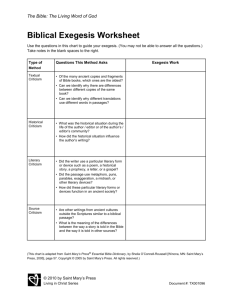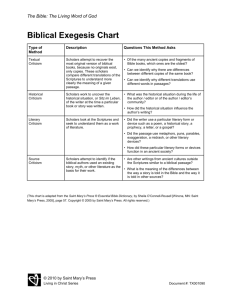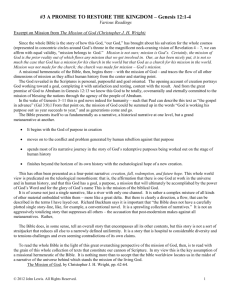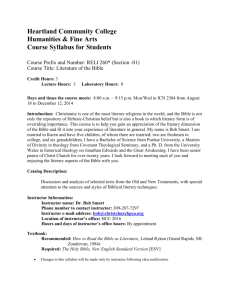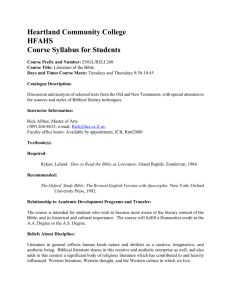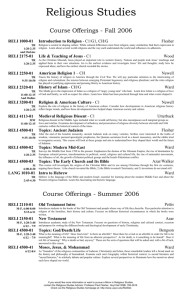RELI260_Apr1999 - Heartland Community College
advertisement
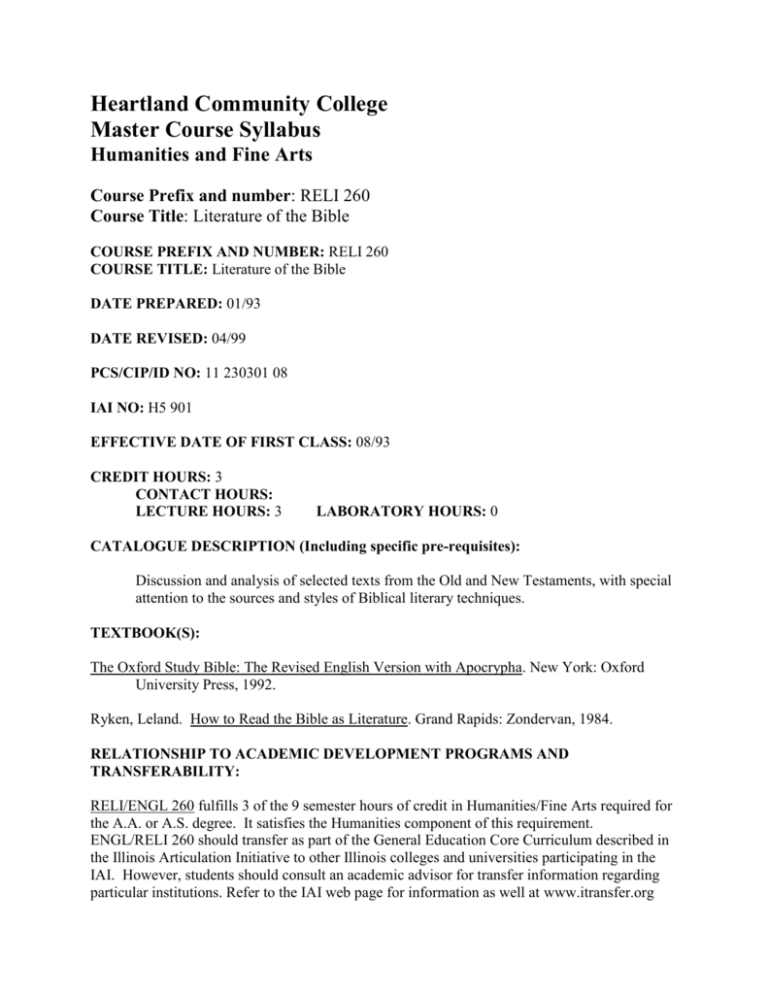
Heartland Community College Master Course Syllabus Humanities and Fine Arts Course Prefix and number: RELI 260 Course Title: Literature of the Bible COURSE PREFIX AND NUMBER: RELI 260 COURSE TITLE: Literature of the Bible DATE PREPARED: 01/93 DATE REVISED: 04/99 PCS/CIP/ID NO: 11 230301 08 IAI NO: H5 901 EFFECTIVE DATE OF FIRST CLASS: 08/93 CREDIT HOURS: 3 CONTACT HOURS: LECTURE HOURS: 3 LABORATORY HOURS: 0 CATALOGUE DESCRIPTION (Including specific pre-requisites): Discussion and analysis of selected texts from the Old and New Testaments, with special attention to the sources and styles of Biblical literary techniques. TEXTBOOK(S): The Oxford Study Bible: The Revised English Version with Apocrypha. New York: Oxford University Press, 1992. Ryken, Leland. How to Read the Bible as Literature. Grand Rapids: Zondervan, 1984. RELATIONSHIP TO ACADEMIC DEVELOPMENT PROGRAMS AND TRANSFERABILITY: RELI/ENGL 260 fulfills 3 of the 9 semester hours of credit in Humanities/Fine Arts required for the A.A. or A.S. degree. It satisfies the Humanities component of this requirement. ENGL/RELI 260 should transfer as part of the General Education Core Curriculum described in the Illinois Articulation Initiative to other Illinois colleges and universities participating in the IAI. However, students should consult an academic advisor for transfer information regarding particular institutions. Refer to the IAI web page for information as well at www.itransfer.org COURSE OBJECTIVES (Learning Outcomes): Students who successfully complete RELI 260 should be able to: 1. Identify the principal literary forms and strategies employed by the writers of the Bible. 2. Identify such literary features as the main features of prose narrative, the structure of an ancient lyrical poem, the form and constituent elements of an ancient letter and letter essay, typical features of symbolic and visionary literature, the elements which comprise a gospel, etc. (D2). 3. Gain an understanding of the literary milieu of the Bible and its surrounding cultures (Ancient Near Eastern, Egyptian, Greco/Roman) and how their interaction helped shape Biblical literature (D1, D3). 4. Understand the historical, social, cultural, and geographical background of the Bible, and identify some of the key dates in Hebrew history (D4, D3). 5. Articulate and communicate some of the major ideas that informed individual works of the Bible, as well as specific pericopes (C7). 6. Understand how the ancient Hebrew literature of the Bible contributed to the development of the later literature of the Bible (D4). 7. Recognize and define terms relevant to Biblical literature such as simile, metaphor, synecdoche, allegory, archetype, type, torah, Pentateuch, Synoptic, parable, pericope, hermeneutics, etc. (D3). 8. Compose brief literary analyses of extended sections of scripture (C1, C2, C3). 9. Identify appropriate topics for scholarly research in biblical literature, utilize standard bibliographic and other research tools, select suitable sources and methodology, and write papers presenting the results of their research while observing the conventions of scholarly discourse (C6). 10. Identify examples of the Bible's influence on English and other literatures, and become aware of the relevance, interaction possibilities, and the dynamics for the communication of Biblical literature to other nations and world cultures (D1, D2, D3). COURSE/LAB OUTLINE: I. INTRODUCTION Bible as Literature, Biblical Literature, Hermeneutics World View and Religious Literature II. CREATION MYTH AND THE FLOOD--PRIMEVAL SAGA, Story of Origins (GEN 1-11) III. NARRATIVE LITERATURE--PATRIARCHAL (GEN 12-50) Abraham and Isaac: Heroic Narrative (Gen 12-26) Joseph in Egypt (Gen 37-50) IV. NARRATIVE AND LAW--TORAH (EXODUS, LEVITICUS, NUMBERS, & DEUTERONOMY--Selected Passages) The Epic of the Exodus, Moses and the Israelites (Exod) Legal Forms and Codes (Exod, Lev, Numb, Deut-- Selected Passages), and Ancient Treaty (Deut) V. NARRATIVE LITERATURE--HISTORICAL (Josh, Judges, Ruth, I and II Samuel, I and II Kings, I and II Chron-- Selected Passages) Judges--Deborah, Ancient Song Ruth--Ancient Story United Kingdom--Saul (Tragic Narrative), David (Heroic Narrative) Divided Kingdom--Israel and Judah VI. PSALM(S)--POETIC LITERATURE, ANCIENT LYRIC Cultic Poetry (Selected Psalms) Personal/Expressive Poetry (Selected Psalms) VII. PROPHETIC LITERATURE Introduction to Prophetic Literature and Literary Forms Major Prophets--Isaiah, and Lamentations (Selected Passages) Minor Prophets--Amos, Micah, and Nahum VIII. WISDOM LITERATURE Ecclesiastes (Chapters 1-12) Proverbs (Selected Passages) IX. GOSPEL(S)--ANCIENT BIOGRAPHY Gospel as a Literary Genre--Ancient Biography Synoptics (Matthew, and Selected Synoptic Parables) X. EPISTOLARY LITERATURE--ANCIENT LETTERS Epistolary Genre--Ancient Letters Occasional letters, General letters, and Pastoral letters (Selected Passages) XI. APOCALYPTIC, VISIONARY LITERATURE--REVELATION XII. INFLUENCE OF THE BIBLE ON ENGLISH LITERATURE, AND THE RELEVANCE, INTERACTION, AND COMMUNICATION OF BIBLICAL LITERATURE TO OTHER NATIONS AND WORLD CULTURES METHOD OF EVALUATION (Tests/Exams, Grading System): Course grades will be determined by total points accumulated during the semester. Points will be assigned as follows: 3 Section Tests 1 Paper (3-5 pages) 2 Selected Readings/With Analytical Notes 1 Oral Class Reading/Or 1 Additional Selected Reading/Notes = = = 400 points 300 points 200 points = 100 points The grading scale used to determine the course grade will be: 92 to 100% 83 to 91% 74 to 82% 65 to 73% Below 65% =A =B =C =D =F REQUIRED WRITING AND READING: One 4-6 page paper is required for the class. It is to be either a literary analysis of a book or extended section of the Bible, or a research paper on the influence of the Bible on English or other world literature. Analytical notes are to be taken and submitted on two selected article readings. A minimum of 6 pages of notes total are required. The student is to complete selected readings from the Bible and from the texts. In addition, the student is to select two additional article readings in the area of Biblical literature besides the general reading for the class.
